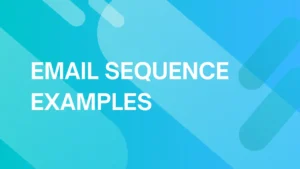
What Are Bounced Emails & How to Solve Them?
When it comes to email marketing and email campaigns, understanding email bounces can make or break a brand’s reputation and the efficacy of its email marketing efforts.
Email bounce rates, a complex measurement of how often your email messages are returned to the sender, can significantly affect a company’s sender reputation.
What Is a Bounced Email?
A bounced email is typically a response from the recipient’s mail server indicating that the email message cannot be delivered.
This can happen for various reasons, ranging from temporary failures, like a full inbox, to more permanent reasons, such as incorrect email addresses or the recipient’s email address doesn’t exist.
Recognizing the distinction between hard and soft bounces, understanding bounce codes, and using specific strategies like double opt-in processes can enhance email deliverability and ensure the success of your email campaigns.
Types of Bounces
1. Soft Bounces
Soft bounces represent temporary issues that can occur with email delivery.
For instance, a soft bounce means that the recipient’s mailbox is full or that the mail server is temporarily down.
It’s essential to understand that soft bounces don’t necessarily imply a problem with the email address itself.
Solutions for soft bounces are often simple: patience and attention to the bounce messages can guide the appropriate action.
Resending the email message after some time may resolve the issue.
However, a consistent pattern of soft bounces may require checking the email content or consulting with the recipient’s email server.
2. Hard Bounces
Unlike soft bounces, hard bounces are a more serious and permanent concern.
Hard bounces occur when there is a non-existent email address, or an SMTP error message is returned due to domain failures.
This makes it vital to verify email addresses, identify bounce notifications, and maintain a healthy subscriber list.
Addressing a hard bounce requires immediate action. The associated email address must be removed, and invalid email addresses should be rectified promptly.
Using email verification tools or a double opt-in process helps in reducing hard bounces and maintaining the hygiene of your email addresses.
Recognizing the fact that hard bounces occur and taking proactive measures keeps email deliverability rates high, and ensures that your emails reach the recipient’s inbox.
Understanding Bounce Codes
Bounce codes are numeric or alphanumeric codes that are included in a bounce message sent by an email server.
They provide specific reasons why an email could not be delivered to the recipient.
These codes help in diagnosing delivery issues and can be essential for troubleshooting problems.
Types of Bounce Codes
1. SMTP Error Codes: These are standardized codes that indicate why the Simple Mail Transfer Protocol (SMTP) failed to deliver the message.
They usually follow a three-digit format, such as “550,” which could indicate a non-existent email address.
2. Extended Bounce Codes: Extended bounce codes offer more detailed information about the bounce.
They might include additional digits or characters to represent specific issues, such as “5.1.1,” which often signifies an invalid recipient address.
Common Bounce Codes and Their Meanings
5xx: Permanent failures, such as:
- 550: Requested action not taken, mailbox unavailable or user not found.
- An error message like “550 high probability of spam” indicates that the server has flagged the email content as likely spam.
- 552: Requested mail action aborted, exceeded storage allocation.
4xx: Temporary failures, such as:
- 421: Service not available, closing transmission channel.
- 450: Requested mail action not taken, mailbox unavailable.
How to Interpret and Act on Bounce Codes
Understanding the bounce code’s meaning is essential for taking corrective action. Here’s how you can interpret and act on them:
- Check the code: Look at the specific bounce code within the bounce message.
- Determine the issue: Match the code with its meaning, using either the standard SMTP error message or the email service provider’s documentation.
- Take corrective measures: Depending on the type of bounce (hard or soft), take appropriate actions such as removing invalid email addresses or investigating why a recipient’s mail server temporarily rejected the email.
How to Reduce Bounce Rates
Bounces are not solely about tools and software. They require strategic planning and thoughtful action. Here’s how:
1. Regularly Clean and Update Your Email Lists
An outdated list with invalid emails can lead to hard bounces. Regular cleaning and updating remove incorrect or non-existent email addresses and improve list hygiene.
By validating email addresses through cross-referencing databases and applying specific algorithms, email verification tools can significantly cut down hard email bounces by making sure the email addresses in your list are valid.
| Tip: Looking for more information about email verification? This post about 6 Email Verification Best Practices in 2023 should do the trick! |
2. Implement Double Opt-in Process
Implementing a double opt-in process is a cornerstone in refining sales prospecting techniques, as it forces subscribers to validate their email addresses.
What is sales prospecting? It’s the process of identifying potential customers and engaging them with the goal of converting them into clients.
This ensures your email list is clean and comprised only of engaged recipients who are more likely to respond positively to your sales efforts.
The double-opt in process sends a test email to the new subscriber’s entered email list, where they then click on a link to fully verify their email address. If they do not verify their email, they aren’t added to the list.
3. Monitor Bounce Reports and SMTP Response
Understanding the reasons behind hard bounces and soft bounces, analyzing full bounce responses, and utilizing bounce codes help you to make timely interventions.
This understanding can help in recognizing why a bounce happened and address the underlying issues leading to diminished email deliverability.
4. Respect the Recipient’s Preference
Acknowledging recipients’ control over the content they receive can foster trust, engagement, and lower bounce rates, both hard and soft.
Making the unsubscribe option readily available is not only a law in many places, it also goes a long way in preventing users from getting annoyed with your company, or reporting your emails as spam.
Best Practices for Keeping Low Bounce Rates
Email marketing efforts are unfortunately not a ‘set it and forget it’ aspect. A successful campaign requires ongoing effort, vigilance, and lots of testing.
Here are some tips to consider while you’re leveling up to be an email marketing master.
a) Always Test Before Sending
Pre-sending tests on various platforms and devices ensure your email messages appear correctly, lessening the chance of triggering spam complaints and bounced emails.
b) Offer Value to Your Recipients
Crafting content that resonates with your audience improves engagement and minimizes the risk of soft bounce and unsubscribes.
c) Work with Reputable Email Service Providers (ESPs)
Choosing an ESP with a good reputation ensures that your emails are handled appropriately, improving email deliverability and minimizing bounce rates.
d) Learn From The Others
Learning from others’ successes and failures provides insights into what works and what doesn’t.
It helps shape your strategies accordingly, offering one solution to avoid the chaos of bounced emails and invalid emails.
| Tip: Check out how Warmup Inbox helped Wishpond improve its email deliverability. |
e) Protect Your Sender Reputation
Working with a reputable email service provider, monitoring bounce messages, and being proactive with authentication settings can safeguard your sender’s reputation.
Remember: a permanently rejected email or a hard bounced message can hurt your standing.
f) Utilize the Right Tools
Investing in specialized tools can be a game-changer in managing email deliverability and bounce rates.
From validating email addresses to handling soft bounce means like full inboxes, the right tool can save you from a sudden increase in email bounces.
Tools like email scraping tools can help you collect email addresses, but it’s crucial to verify these addresses to avoid high bounce rates.
| Tip: If you’re looking to start your first email marketing adventure, check out our Beginner’s Guide for a Successful Email Campaign. |
g) Know how to send an email to multiple recipients individually
Understanding how to send an email to multiple recipients individually can help maintain personalization and reduce the chances of your emails being marked as spam.
This practice ensures that each recipient feels valued and reduces the likelihood of triggering spam filters.
Integrating Warmup Inbox to Improve Email Deliverability
Warmup Inbox can take your email deliverability to new levels by warming up your email account and decreasing both hard and soft bounces.
By sending multiple emails to known addresses in increments, Warmup Inbox helps your sending domain’s reputation grow in a positive way, which also helps in reducing bounced emails.
So, what are you waiting for? Try Warmup Inbox by signing up for a free trial today!
Conclusion: The Path to Effective Email Marketing
Understanding the multifaceted nature of email deliverability is paramount in the digital marketing landscape.
By investing in the proper tools, distinguishing between hard and soft bounces, and using a strategic, methodical approach, businesses can develop robust email campaigns and significantly diminish high bounce rates.
In the intricate journey toward reducing bounce rates and amplifying email marketing efficacy, a careful blend of attention to detail, continuous monitoring, agility in adaptation, and intelligent utilization of tools, such as Warmup Inbox, emerges as the cornerstone.
Together, these elements forge a path that not only targets successful email delivery but cultivates a thriving relationship with the audience, ultimately enhancing the overall marketing strategy.
Frequently Asked Questions
What are email bounces and how do they affect my campaign?
Email bounces refer to the process in which an email is rejected by the recipient’s mail server. They significantly impact your email marketing efforts by lowering deliverability rates, affecting your sender reputation, and potentially causing your emails to be marked as spam.
What’s the difference between hard bounces and soft bounces?
Hard bounces occur when an email address doesn’t exist or is invalid, resulting in a permanent failure. In contrast, soft bounces are temporary failures, such as a full inbox or a problem with the recipient’s email server.
What is a bounce message, and how do I interpret it?
A bounce message is a notification sent by your recipient’s mail server to explain why an email bounced. These messages may contain specific bounce codes or error messages, such as an SMTP error message, detailing the reason for the bounce.
How can I reduce bounce rates in my email campaigns?
Reducing bounce rates in your email campaigns requires careful practice. By validating email addresses, avoiding sending to non-existent email addresses, respecting spam filters, and following best email practices, you can minimize both hard and soft bounces. Tools and techniques like email address validation can significantly reduce bounce rates and boost overall email performance.
What is an email bounce code, and how do I use it?
An email bounce code is part of the bounce response, providing specific information about why an email bounced. These codes can reveal issues such as invalid email addresses or SMTP response errors. Understanding email bounce codes helps in diagnosing and addressing the underlying problems that lead to bounced emails, which then improves email deliverability.



